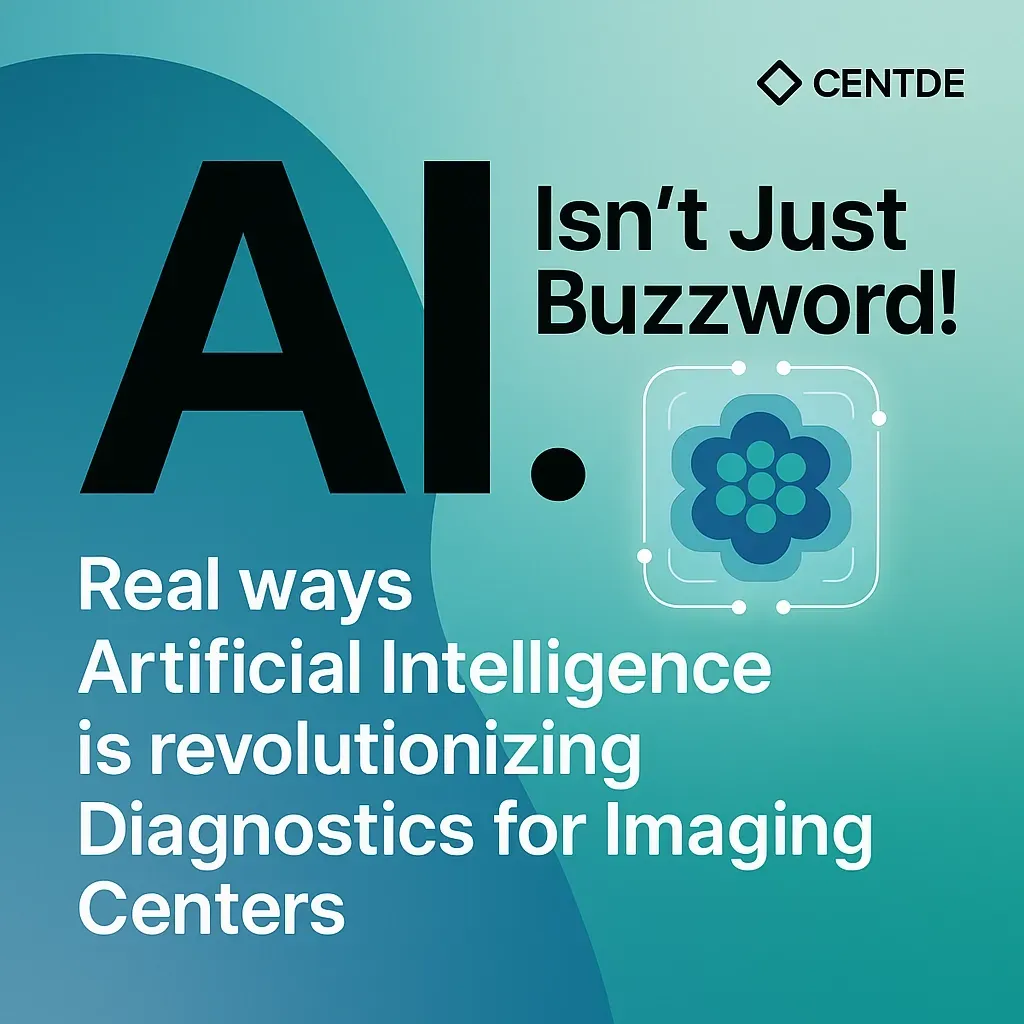
Real Ways Artificial Intelligence Is Revolutionizing Diagnostics for Imaging Centers
Beyond the AI Hype
Artificial intelligence has moved far beyond trendy conference presentations and speculative industry forecasts. In 2025, AI is delivering tangible, measurable results in diagnostic imaging centers across the country. The transformation isn't just happening; it's already here, changing how radiologists work, how patients receive care, and how imaging center leaders make business decisions.
"AI in healthcare isn't about replacing human expertise; it's about augmenting it," says Dr. Rachel Chen, Chief of Radiology at Northeast Medical Imaging. "What we're seeing now is AI helping radiologists be more confident, more efficient, and ultimately more effective in patient care."
For imaging center administrators and radiologists alike, understanding these real-world applications of AI isn't just about staying current with technology—it's about remaining competitive in an increasingly digital healthcare landscape. Let's examine how AI is truly revolutionizing diagnostic imaging, with practical examples that demonstrate its value beyond the marketing hype.
Enhanced Diagnostic Accuracy: Finding What Human Eyes Miss
Pattern Recognition at Superhuman Scale
One of AI's most significant contributions to diagnostic imaging is its ability to detect subtle abnormalities that might otherwise go unnoticed. AI algorithms can analyze thousands of images with consistent accuracy, identifying minute changes in tissue structure that might signal early disease.
For example, AI-powered mammography systems have demonstrated the ability to detect breast cancer up to 18 months earlier than traditional methods. These systems don't just look for obvious masses; they analyze tissue patterns and density variations that might be imperceptible to even experienced radiologists.
Reducing False Positives and Negatives
Every radiologist knows the anxiety of potential misdiagnosis—both false positives that lead to unnecessary procedures and false negatives that miss critical conditions. AI is helping address both concerns.
In lung cancer screening, AI algorithms have reduced false positives by up to 25% while simultaneously improving early detection rates. This translates to fewer unnecessary biopsies and follow-up procedures, reducing patient anxiety and healthcare costs while ensuring genuine concerns aren't overlooked.
"The reduction in false positives we've seen with our AI-assisted lung screening program has been remarkable," notes Dr. Marcus Johnson, Medical Director at Western Regional Imaging. "We're catching more early-stage cancers while simultaneously reducing unnecessary follow-up procedures."

Workflow Efficiency: Transforming Radiology Operations
Prioritization of Critical Cases
In emergency imaging, minutes matter. AI systems are now capable of triaging incoming scans, flagging potential life-threatening conditions like intracranial hemorrhages, pulmonary embolisms, or aortic dissections for immediate review.
This capability means the most urgent cases get seen first, potentially saving lives in time-sensitive situations. At Central Metro Hospital, implementing AI triage for CT scans reduced the time to detection for critical findings by an average of 31 minutes—a difference that can significantly impact patient outcomes in stroke or trauma cases.
Automated Measurement and Reporting
Quantitative measurements in imaging are time-consuming but essential. AI now handles many of these tasks automatically:
Tumor volume and growth rate calculations
Cardiac function measurements
Bone density assessments
Vessel stenosis quantification
These automated measurements aren't just faster; they're often more consistent than manual measurements, reducing inter-observer variability and providing more reliable tracking of disease progression over time.
Workload Distribution and Radiologist Burnout Prevention
Radiologist burnout is a growing concern in healthcare. AI helps address this by handling routine screening cases and repetitive measurements, allowing radiologists to focus on complex cases that truly require their expertise.
"Before implementing AI assistance, I was reading over 100 screening mammograms daily, alongside diagnostic work," says Dr. Sarah Williams of Southcoast Women's Imaging. "Now our AI system pre-screens normal cases, and I can dedicate more time to the complex diagnostic cases where my expertise makes the biggest difference. It's changed how I practice and honestly probably extended my career by years."
Personalized Medicine: The AI Advantage
Predictive Analytics for Treatment Planning
Perhaps one of the most exciting applications of AI in imaging is its ability to predict disease progression and treatment response. By analyzing imaging biomarkers alongside clinical data, AI models can help forecast:
Tumor aggressiveness and likely response to specific therapies
Stroke risk in patients with carotid stenosis
Fracture risk in osteoporosis patients
Progression likelihood in neurological conditions
These predictions help clinicians and patients make more informed treatment decisions based on individualized risk assessments rather than population averages.
Radiomics: Extracting More Value from Every Image
Radiomics—the extraction of quantitative features from medical images—represents a frontier where AI excels. These systems can identify hundreds of image features invisible to the human eye, correlating them with clinical outcomes to provide deeper insights.
For example, AI radiomics analysis of lung nodules can differentiate between benign and malignant findings with greater accuracy by examining texture patterns, shape characteristics, and other quantitative features that traditional visual assessment might miss.

Real-World Implementation: Success Stories from the Field
Case Study: Community Hospital Adoption
Riverside Community Hospital, a 220-bed facility serving a rural community, implemented an AI-assisted chest X-ray system in 2023. Within six months, they documented:
22% increase in pneumonia detection
15% reduction in report turnaround time
8% decrease in callback exams
These improvements occurred despite having only two full-time radiologists on staff, demonstrating AI's potential to enhance care even in resource-limited settings.
Case Study: Multi-Site Imaging Network Standardization
Pacific Imaging Associates, a network of 12 outpatient imaging centers, faced challenges maintaining consistent quality across locations. Their implementation of an AI quality assurance system allowed them to:
Standardize reporting across all sites
Reduce variability in measurements between radiologists
Identify and address protocol adherence issues
Provide targeted feedback and training to technologists
"The standardization we've achieved through our AI implementation has been game-changing for our multi-site operation," says Maria Rodriguez, COO of Pacific Imaging Associates. "Referring physicians now know they'll get the same quality report regardless of which of our locations their patient visits."
Overcoming Implementation Challenges
Despite its potential, AI implementation in imaging centers isn't without challenges. Common hurdles include:
Integration with Existing PACS and RIS Systems
Many imaging centers struggle with integrating AI tools into their existing picture archiving and communication systems (PACS) and radiology information systems (RIS). Successful implementations typically involve:
Selecting vendors with proven integration capabilities
Planning for adequate IT support during transition
Ensuring proper DICOM compatibility
Establishing clear workflows for AI findings within existing systems
For assistance with integration challenges, Imaging Media Group offers specialized consulting services to ensure smooth implementation.
Radiologist Adoption and Training
Radiologist resistance can derail even the most promising AI initiatives. Successful centers approach this challenge by:
Involving radiologists in the selection process
Starting with narrow, high-value use cases
Providing adequate training and support
Emphasizing AI as an assistant, not a replacement
Sharing success metrics regularly
ROI Justification and Reimbursement Considerations
The financial case for AI remains challenging in some contexts. Forward-thinking imaging centers address this by:
Documenting efficiency gains in concrete terms (reports per hour, turnaround time)
Tracking quality improvements and error reduction
Measuring patient satisfaction and referrer feedback
Building business cases that include both direct revenue and cost avoidance
Exploring new value-based care models where quality improvements directly impact reimbursement

Future Directions: What's Next for AI in Imaging?
Multimodal Integration
The next frontier in AI diagnostics involves integrating information across multiple imaging modalities (CT, MRI, ultrasound, PET) alongside clinical data, lab results, and genomic information. These comprehensive models promise even greater diagnostic accuracy and personalized treatment recommendations.
Automated Follow-Up Management
AI systems are beginning to track findings over time, automatically identifying when follow-up imaging is needed and flagging cases where recommended follow-up hasn't occurred. This capability helps prevent dangerous gaps in care that can occur when incidental findings aren't properly tracked.
Patient-Facing AI Applications
Patient engagement applications powered by AI are emerging as valuable tools for imaging centers. These include:
Automated appointment reminders with preparation instructions
AI chatbots that answer common patient questions about procedures
Personalized education materials based on scheduled exams
Post-procedure follow-up and satisfaction monitoring
Learn more about patient engagement strategies in our previous article on automated patient engagement in radiology practices.
Federated Learning Models
Privacy concerns remain paramount in healthcare. Federated learning—where AI models are trained across multiple institutions without sharing actual patient data—is emerging as a solution that allows for robust algorithm development while maintaining strict patient privacy.
Practical Next Steps for Imaging Centers
For imaging center leaders considering AI implementation, we recommend a phased approach:
Assessment: Evaluate your current workflow challenges and identify areas where AI could provide the greatest impact. Common starting points include mammography, chest X-ray, and stroke detection.
Vendor Selection: Research vendors with solutions addressing your specific needs. Prioritize those with proven integration capabilities with your existing systems and documented clinical validation.
Pilot Implementation: Start with a limited scope implementation in one area, with clear success metrics defined in advance.
Workflow Integration: Develop clear protocols for how AI findings will be integrated into radiologist workflows and final reports.
Training and Change Management: Invest in comprehensive training for all staff, with special attention to radiologists and technologists who will interact most directly with the new tools.
Ongoing Evaluation: Establish regular review processes to assess the impact of your AI implementation and identify opportunities for expansion or refinement.
For assistance with any of these steps, Imaging Media Group's consulting team specializes in helping imaging centers successfully implement AI solutions.
Beyond Image Analysis: AI for Business Operations
While diagnostic applications receive the most attention, AI is also transforming business operations for imaging centers:
Scheduling Optimization
AI scheduling systems can predict no-show rates based on patient demographics, appointment types, and historical patterns, enabling overbooking strategies that maximize scanner utilization without creating excessive wait times.
Revenue Cycle Management
AI tools for revenue cycle management can:
Predict claim denials before submission
Identify coding opportunities for appropriate reimbursement
Automate prior authorization processes
Flag documentation gaps that could impact reimbursement
Marketing and Referral Pattern Analysis
AI-powered marketing tools can analyze referral patterns, identify potential new referral sources, and optimize outreach efforts. These tools can also help track the effectiveness of marketing campaigns and adjust strategies accordingly.
For more insights on marketing strategies for imaging centers, read our guide on optimizing diagnostic imaging marketing.
Conclusion: The AI Imperative for Imaging Centers
Artificial intelligence has moved far beyond hype to become an essential component of modern imaging practice. The question for imaging centers is no longer whether to implement AI, but how to do so strategically to maximize clinical value and operational efficiency.
Centers that successfully integrate AI into their operations are seeing tangible benefits in diagnostic accuracy, workflow efficiency, and business performance. Those that delay implementation risk falling behind both clinically and competitively.
The key to success lies in approaching AI implementation thoughtfully, with clear goals, appropriate vendor selection, and comprehensive change management. By focusing on specific, high-value use cases and measuring outcomes rigorously, imaging centers can ensure their AI investments deliver meaningful returns.
Ready to explore how AI can transform your imaging center? Contact Imaging Media Group for a personalized consultation on AI implementation strategies tailored to your specific needs and challenges. Our team of healthcare marketing and technology experts can help you navigate the complex landscape of AI solutions and develop an implementation roadmap that delivers real clinical and business value.
The future of diagnostic imaging is here—and it's smarter than ever before.
Still have questions? Want to see how we can help you achieve success? Reach out.
Use the form to the right to reach out to us and speak with a representative, and learn how you can grow your Imaging Center.
Let's Chat
Contact Us
© 2025 Imaging Media Group - All Rights Reserved
Imaging Media Group and SalesPilot CRM are divisions of Mixed Media Ventures

